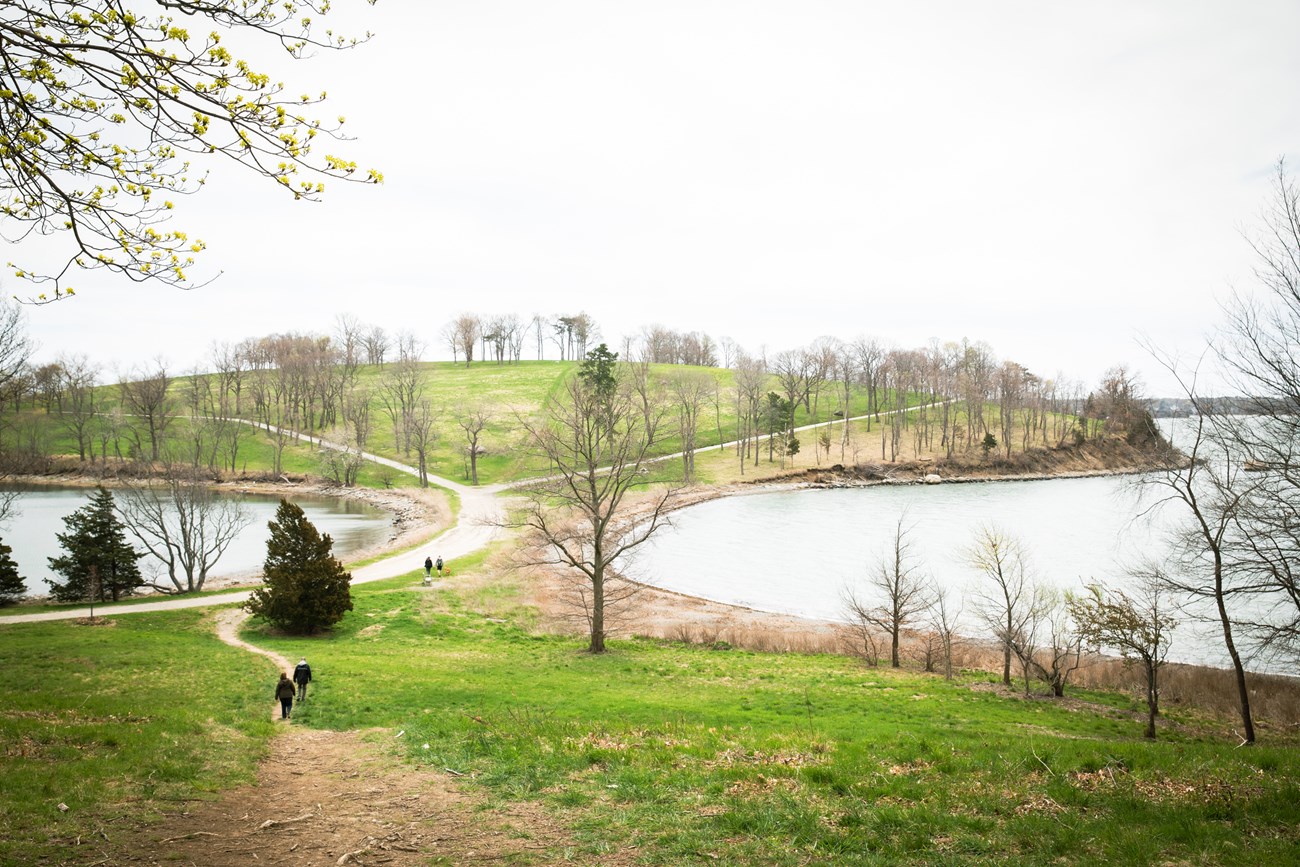
Photo by Matt Teuten The landscape plantings and roads of this large peninsula were designed by Frederick Law Olmsted. Overlooking Hingham Bay, World's End is formed by two drumlins and has rocky beaches, ledges, cliffs, patches of salt marsh and an area of freshwater marsh. Some of the peninsula's features derive from landscape architect Frederick Law Olmsted's plan for the area, including gravel paths, formal tree plantings, and hedgerows. General InformationThis island of Boston Harbor Islands National and State Park is managed by The Trustees of Reservations. Visitor Facilities & Services
On-island Circulation: The reservation contains approximately 3.5 miles of gravel roads and 2.3 miles of mowed grass trails. Short HistoryLocal Indigenous communities accessed Worlds End as a seasonal campsite for for thousands of years. After European settler colonization, farming continued for over three hundred years. Toward the end of the 1800s, there was an attempt by property owner John Brewer to subdivide Worlds End into 163 house lots. The plan was never realized, though the groundwork was laid by the landscape architect, Frederick Law Olmsted. The Trustees of Reservations purchased the northern half of the peninsula in 1967 to preserve and protect it for public enjoyment. Natural History OverviewVegetationWorlds End contains a fascinating mix of planted and natural vegetation and, without structures, is a very dramatic planted, designed landscapes worthy of more in-depth study. The original planting configuration along the roads, double rows on each side is still visible in most area but obscured by encroaching vegetation in others. A single row of enormous oaks, planted perpendicular to the road over Pine Hill is spectacular. The summit of Pine Hill is marked by an enormous pine. The summit of Planters Hill is a meadow. The Trustees cut meadow areas for hay once or twice a year. The northern most drumlin, Worlds End, and the Rocky Neck area are maintained as woodland. The property offers an excellent example of how a landscape architect’s vision can define spaces and mark the land. Tree species lining the road are mixed, including several varieties of oak, maple, ash, larch, catalpa, tulip tree, and pine. In many areas it is apparent that trees have died and been removed. No doubt elms were originally included in the palette of street trees. In some places trees have been replaced though it is unclear whether they are replaced in kind and in the same location. Further research and documentation is recommended in the format of a Cultural Landscape Report. WildlifePlease see Animals page for more information. GeologyWorlds End is composed of four hills drumlins of glacial till deposited on underlying bedrock and running roughly north to south. The highest drumlin is 140 feet above sea level, offering one of the highest vantage points in the harbor. An enormous inland rock outcrop is located near the visitor parking area and "Damde Meddowes." Smaller rock outcrops are located along the Weir River, including Ringbolt Rock, and throughout Rocky Neck. The shoreline contains sections of outcroppings, rock -strewn beaches, sandy coves, and salt grass marshes. Water FeaturesThere are two inland water bodies, the Ice Pond on Rocky Neck and the Damde Meddowes. The Damde Meddowes, now a brackish wetland, is the result of an un-maintained constructed water feature; two dams and a pump house built in the seventeenth century to remove standing water from this area for agricultural use. Once the pump house ceased to operate, the area filled with water. A well, located near the entry gate, believed to date to seventeenth century owner, Abraham Martin, is no longer visible. TTOR Staff member Joseph Lincoln, who resides adjacent to the entry gate, recalls that his father filled in the well for the safety of his children. Drainage ditches line roads and paths throughout the property. Water is directed into culverts, some stone capped and others concrete, and passes under roads by metal or ceramic drainpipes. Some hillside roads have surface water bars consisting of two timbers anchored with metal plates. Views and VistasWhen seen from Hingham Bay, Hull or by airplane from overhead, Worlds End presents itself as a conundrum, roads lined with trees and open fields, but no houses. Seasonal changes in the colors of the fields and trees heighten its visibility. From within its views are even more appealing. Distant views are framed by mature tree trunks, an interlocking canopy above, and convex grassy meadow below. The great size of the property and changes in views allow for a multitude of wonderful views over Hingham Harbor and its small islands, Hingham Bay and Grape, Slate, Bumpkin and Peddocks Islands, and Hull and the Weir River tidal flats. Structures
|
Last updated: November 30, 2023
